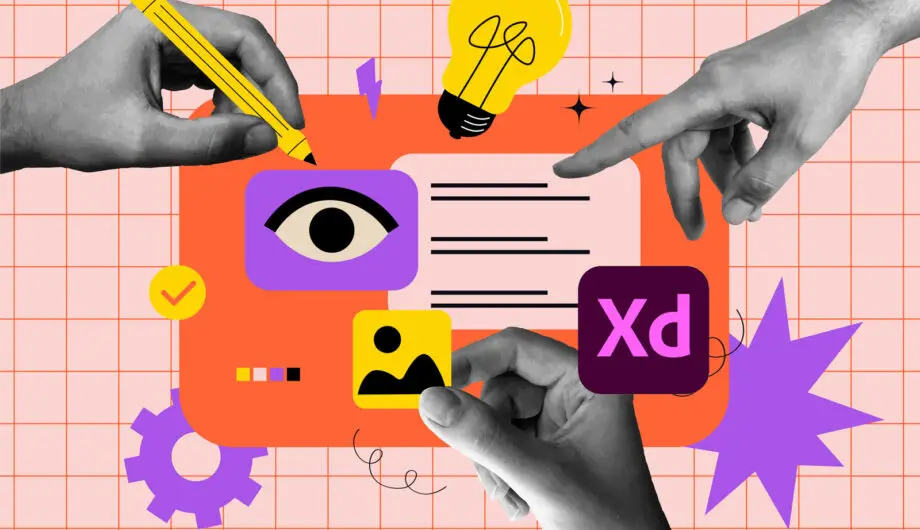
Do you want to design your own website in Adobe XD, but want a website built in WordPress? We can do that! Adobe XD to WordPress conversion is our specialty. In fact, we design all our websites in Adobe XD. If you’d like to design your own site and have the skills to create it, but don’t know how to convert that into a WordPress theme, we can take care of that for you.
What is Adobe XD?
Adobe XD (Experience Design) is a vector-based design tool developed and published by Adobe Inc. It’s primarily used by UX (User Experience) and UI (User Interface) designers to create, prototype, and share designs for various digital products, including:
- Websites: Designing layouts, navigation, and interactive elements.
- Mobile Apps: Creating user interfaces for iOS and Android applications.
- Other Digital Interfaces: This can include dashboards, e-commerce platforms, educational apps, and more.
How do we convert Adobe XD to WordPress?
People create websites in a lot of different ways, but our process is for Susan to design the website in Adobe XD, and for me (Amy) to build a custom WordPress theme based on the design she creates. However, while Susan custom designs websites for our clients, we are happy to build custom themes for anyone who has designed a site in Adobe XD. (Or Photoshop or InDesign or Figma, whatever software you prefer.)
Here’s how we do it:
Once the design is approved, we start by exporting all the assets. These are all the photos, logos, and graphics we’ll need to create the theme.
Next, we start with our WordPress blueprint.
A WordPress “blueprint site” refers to a pre-configured WordPress setup that serves as a template or starting point for creating new websites. Instead of building a WordPress site from scratch every time, a blueprint allows us to quickly deploy a site with our preferred themes, plugins, settings, and even sample content already in place.
Here’s a breakdown of what that entails and why it’s useful:
- Pre-defined Configuration: A blueprint essentially packages up a complete WordPress installation with specific settings. This can include:
- Themes: Your go-to theme or a selection of themes. We are Beaver Builder Pros, so we use the Beaver Builder theme as our starting point, and create a custom child theme for the new design. We keep a blueprint with our preferred theme and settings already configured and ready to go.
- Plugins: All the essential plugins that we use on every site. Some of ours include: Beaver Builder, Gravity Forms, Site Kit by Google, among others.
- Site Options: General settings like site title, tagline, permalink structure, reading settings, etc. These task don’t seem like they take a long time, but they save a lot of time if you build a lot of websites. And we do.
- Starter Content: Pages, posts, menus, and media that you often include on new sites. I can tell you that many sites start with the same type of pages: home, about, services, blog, faq, and contact are frequent items in the navigation. So my blueprint has those pages already set up. All we have to do is add content and customize.
Now that we have a blueprint ready for building and our assets, it’s time to put those together. I start with my global elements.
On a WordPress website, “global elements” refer to components of your site’s design and content that are intended to be consistent and reusable across multiple pages or even the entire website.
Here’s a breakdown of what “global elements” typically encompass:
- Layout: Control the default content width, wide width, and full width settings for blocks and overall page structure.
- Global Styles: This is a core aspect of global elements in modern WordPress. With block themes and the Site Editor (Appearance > Editor), you can define site-wide styles for:
- Typography: Default fonts, font sizes, line heights, and appearances for all text, headings, and links.
- Colors: Define color palettes for your site’s background, text, links, and various blocks. This ensures brand consistency.
- Buttons: Create a custom template so all buttons appear the same throughout the site.
- Header: This is the top portion of your website, usually including your logo, navigation, maybe a search box, your phone number, or social media icons. This will usually be the same on every single page. Not always, but usually.
- Footer: This is the lowest portion of the website, and often includes some quicklinks, social media icons, maybe a logo. Sometimes a search box, and often contact information. And again, this is usually the same throughout the website.
Once I have the global elements completed, I will start laying out the content on each page. Content is important, and it’s often the hardest part of the process for people to plan out. I recommend starting with the easy pages – the contact page for example, which will often just have a couple of sentences and then your contact information and a form. Then once you get the simple pages, move on to the more complicated pages.
I consider building out pages with great layouts one of my specialties. If you can give me the content, I can lay it out so it’s easy to read, looks great, and isn’t overwhelming. User Experience is key.
Finally, once I have all the content, I’ll go back through every page and check my mobile settings, to be sure that the site is going to look great across all devices.
Once we have the site finalized and are ready for launch, then we’ll go through our extensive launch process, which includes pushing the site to the final hosting account, setting up Google Analytics, security, and hopefully getting it set up on one of our support plans, which helps keeps your site up and running and secure.
The conversion from Adobe XD to WordPress can be more complicated, of course, depending on any advanced functionality you may need, but this post outlines the basic steps I would take for a brochure website to get it from design to live.
One thing to keep in mind when designing in Adobe XD is that you are usually creating a fixed size with your design, and when you get it in the browser, it needs to be responsive for various devices, so keep in mind that the size adjustments may have it not looking exactly like your intended design and that’s okay. We are a responsive web design agency, so want the site to be responsive so that it looks great on every device.
Need help getting your website from Adobe XD to WordPress? Contact us today for a quote!
Amy Masson
Amy is the co-owner, developer, and website strategist for Sumy Designs. She's been making websites with WordPress since 2006 and is passionate about making sure websites are as functional as they are beautiful.
